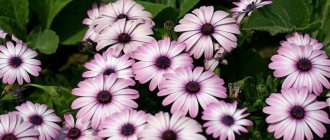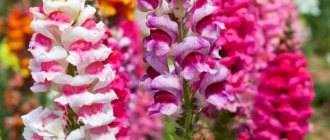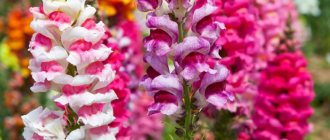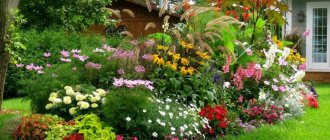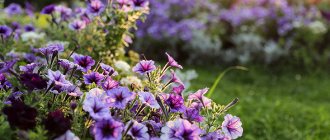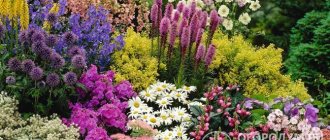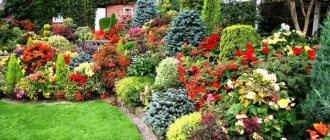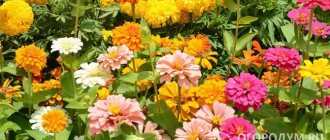Low-growing, beautifully flowering plants do not exceed 30 cm in height. They are compact, decorative, and have abundant flowering. They are indispensable in the first row of flower beds, borders, ridges, and are used in the design of alpine slides and rockeries. Low-growing flowers for a flower bed can be found both in the group of annuals and among perennials. To create spectacular long-flowering compositions on the site, it is better to use both.
Low-growing flowers are planted both individually and in combination with each other, as well as with tall species
General information
A universal solution for a flower bed will be annual flowers. Why?
- They are blooming! That is, right away. It is the peony that can wait several years for its first buds, but the little pansies will show themselves as quickly as possible.
- Plant types can be changed every year. Get the hang of it, even over the course of a season. Vary colors, find out what grows best.
- Garden annual flowers do not require the intricacies of year-round care. There is no need to divide the bushes, dig up bulbs, or develop a complex feeding system.
Just what you need if you have little experience, it’s difficult to water, and the description of fertilizers makes your eyes glaze over. For a beginner, in order not to be disappointed, for the first experience it is worth choosing viable annual flowers that bloom all summer.
Mixborders
Mixborders are unique flower beds with several levels. Often plants are planted in blocks. It is important to choose the types of colors so that the blocks have different heights and colors. In such a multi-level composition, when the flowering period of one species ends, it is replaced by a second.
Mixborders are actively used by landscape designers because they look impressive, much more interesting than conventional flower beds.
How to choose?
In the city, popular species can be easily identified by looking at the landscaping areas maintained by municipal contractors. In addition to the obligatory roses and tulips, there will probably be annual flowers blooming in all shades of pink, purple and yellow: petunias, marigolds and violets. Their advantage is their unpretentiousness and a huge selection of varieties; zoned seedlings are available in any garden center; they are decorative until late autumn.
When choosing what to plant, keep in mind that gardeners' advice is not universal. You need to take into account the climate in your region. The fact that in the Kuban it is permissible to sow directly into the ground as early as March, somewhere to the north it is necessary to cultivate it in the form of seedlings until the end of May.
In rural areas it is worth spying on your neighbors. Front gardens will illustrate which species and variety survive best. And then only the taste of the gardener and the size of the plant are taken into account.
Annuals
To the delight of flower growers, the list of low-growing flowers for flower beds that bloom all summer is quite large and is constantly updated with new varieties, which are bred by foreign and domestic breeders. Moreover, within one plant genus there are often a number of varieties. For example, petunia, which has ampelous, spreading bush and dwarf forms. Or universal participants in various plantings in the garden - marigolds, divided into erect, deviated, thin-leaved.
Ageratum
Ageratum Mexicana is also known as “long-flowered,” which is explained by its ability to bloom from June until the coldest weather . Forms straight, branched, strong bushes covered with colorless hairs. The leaves are arranged oppositely. Blue, white, blue, lilac and pink narrow-tubular flowers are collected in an inflorescence-basket, up to 1.5 cm in diameter. Several baskets make up a shield.
Ageratum is planted along paths in the garden, in flower beds, alpine hills, dwarf forms are suitable for container growing
Alyssum
Sea alyssum (mason, alyssum) belongs to the Brassica family. This small (5-20 cm) herbaceous plant with almost recumbent stems and narrow leaves forms lush flowering bushes. Caps of small, fragrant honey flowers of white varieties resemble clouds. Blooms from June until frost . It is not difficult to grow seedlings, especially since the seedlings are not as thin as those of lobelia, and are planted later - in early April. Seeds can be sown directly in open ground at the end of April or before winter.
Alyssum is a mountain plant, so it prefers open sunny areas, ideal for rocky gardens, borders, hanging baskets, flowerpots
Marigolds (tagetes)
These sunny, unpretentious, fast-growing flowers have been popular in our country for several decades. Growing them is a pleasure - those sown in April through seedlings sprout quickly and amicably. They will also grow well in a greenhouse or open ground. They love sunny places, but also tolerate partial shade. They bloom from June to October . For the first plan of a flower bed, creating spots of color, flowerpots, boxes, you can choose low-growing varieties of terry and simple shapes. Marigolds come to the rescue when you need to fill empty spaces.
Thin-leaved marigolds go well with blue lobelia (photo by the author)
Begonia everblooming
A popular participant in urban decorative landscaping, it turns out that it has been loved by flower growers since the 19th century for its constant flowering and ease of care. The plant can be used not only as a seasonal flower bed, but also as an indoor one. They usually plant seeds for seedlings, starting in February (additional lighting is needed). If you only need a few bushes to create a small composition, it’s easier to buy them in flower shops in the spring.
The most common varieties are those with white, pink and red petals.
Verbena
Compact forms of verbena reach only 20-30 cm in height. The plant is pubescent. The leaves are serrated and oblong. The flowers are regular, sessile, varied in color, collected in an inflorescence - a corymb. Blooms from June to October. Seedlings are sown in March.
To get a bright flower bed, you can plant one variety or a multi-colored mixture
Lobelia
An undoubted decoration of the garden, verandas, and balconies is lobelia. Among the low-growing varieties with a height of 15-30 cm, it is worth highlighting: “Purple Palace”, “White Palace”, “Pink Riviera”, “White Riviera”, “Regatta Sky Blue”, “Beauty of Russia” (mixture). The two-color options are especially beautiful - with a white eye.
Lobelia seeds are very small; they are sown for seedlings in February, scattered over the surface of the soil, covered with glass or film until germination. The most difficult care is when the seedlings are small: careful, timely watering is needed. From a strong stream or overflow, seedlings can fall down and die. You need to plant 3-4 plants in separate cups for better stability and survival rate. So, in groups, and subsequently planted in open ground.
Lobelia, like alyssum, blooms from June to late autumn. The photo was taken on November 1, 2021 in the Tver region (photo by the author)
Snapdragon
Snapdragon (antirrhinum) belongs to the Norichinaceae family, and its origin comes from the Mediterranean. It has highly branched, densely leafy stems. Blooms 60-80 days after germination. Flowering is abundant and long - from early summer to late autumn . The flowers range in color from pure white to dark purple, in a variety of shades and combinations. Collected in spike-shaped inflorescences.
More than 800 varieties are known. Among the short ones, the following have proven themselves well: “Schneeflocke”, “Snapshot Burgudni”, “Kimono greenish-yellow”, “Kimono apple blossom”, mixtures “Round Dance”, “Magic Carpet”, “Bright Kimono”.
Antirrinum is grown in seedlings and without seedlings, used to decorate flower beds, balconies, loggias
Nemesia goiter
Nemesia also belongs to the Norichnikov family; the plant’s homeland is Africa. Flower growers appreciated it for its variety of colors, abundance, and decorative flowering. Nemesia is good in single plantings, in flower beds, hanging baskets, and pots. Seeds are sown for seedlings in March - early April, in the south they are sown directly into the ground.
The variety of colors of nemesia is amazing; there is a similarity with snapdragons, pansies, and white and blue varieties vaguely resemble lobelia
For better tillering of lobelia, alyssum, and nemesia, the tops of seedlings should be pinched.
Low growing nasturtium
Southern nasturtium loves warmth, light, and does not tolerate drought. It is recognizable by its long, climbing stems, beautiful rounded leaves, large flowers with a distinctive aroma and special, large, ribbed seeds that can be pickled like capers. But among the climbing forms there are also compact, low-growing ones: “King Theodore”, “Day and Night”, “Mahogany”, “Golden Ball”, “Baby Salmon”.
Nasturtium "Alaska" is notable for its variegated foliage
Petunia
Speaking about low-growing annual flowers for flower beds, one cannot ignore the “star” of flower beds and balconies - petunia, which belongs to the Solanaceae family. The range of hybrids is extremely large. For open ground, it is recommended to choose compact, spherical, low-growing forms with simple colors: “Cherry Crystal”, “Chirosis blue and white”, “Pikoti”; terry: “Duo Salmon”, “Duo Burgundy”, “Tarte Bonanza”.
Multi-tiered flower bed of different varieties of petunias with a simple corolla shape
Cellosia
A representative of the Amaranthaceae family, it belongs to the group of dried flowers - it is perfectly preserved when cut and is used to create winter bouquets. There are three forms: pinnate, comb, spikelet. Blooms from July to October .
Cellosia pinnate in the foreground of the garden path border, in the background are marigolds
Zinnia
It is an erect plant with a fairly powerful, strong stem. Low-growing varieties are distinguished by a spherical, compact bush shape. The inflorescences have a diameter of 5-6 cm, the densely double ones are especially beautiful. They bloom from June to autumn . Growing from seeds is not difficult because the seeds are large. They are planted as seedlings in April or sown in open ground in May.
Particularly interesting are two-color hybrids, for example, “Swizzle Cherry Ivory” (pictured)
Additional information about the different types of annuals used to decorate flower beds can be found in the article on our website.
Zinnia
It even bloomed in space! The very first among other plants. This happened on board the International Space Station in 2016. It will be easy to grow zinnia in Earth's gravity conditions. Its petals are lush, arranged in tiers, like tiles. It responds well to watering and fertilizing.
This is the case when care works wonders. The more you give her, the thicker and more beautiful the flowers. They come in different colors, from white to bright red, but not blue. The size of zinnia depends on the variety. Dwarf bushes are similar to classic marigold bushes, tall ones (60-90 centimeters) are similar to dahlias.
Among the low-growing annual flowers there are others that are resilient and elegant.
Basic rules for arranging a flower bed
Before deciding on a planting location and deciding how to make a flower bed, you need to take into account a few simple rules:
You need to carefully consider the location of the flower bed. The area should be sunny and not windy. It is necessary to think about not only the aesthetic appearance of the flower bed, but also to create comfortable conditions for the flowers.
Take into account such a factor as practicality. Give preference to one large beautiful flower bed instead of several small ones. It is very comfortable. Subsequently, you will not have to go around the entire garden in search of randomly planted clusters of flowers.
At the same time, you should not focus too much on the whimsicality of the external contours of the object. Give flower beds unusual shapes. Of course, they always look great, but they can be quite difficult to create for a novice gardener.
First, take paper, colored pencils and a template, sketch out a plan for the “flower island” and arrange the flowers the way you would like to see them in the future. There is no need to create colorful combinations. It looks tacky.
If you want to combine many bright flowering plants in one place, you can effectively divide them into monochromatic stripes. For example, plant one path with white flowering plants, another with red or yellow ones. Alternate colors depending on the chosen palette. It looks very nice.
It will be important to determine the height of the plantings in advance. This moment plays a very important role. Remembering once again about random planting, we can say that this applies not only to the species, but also to the parameters. So, it is best to use low-growing flowers for edging a flower bed. Such as phlox, dwarf irises, delphiniums and so on.
Climbing higher, plant begonias or zinnias, which are medium-sized species. It is beautiful to arrange tall flower crops and ornamental shrubs in the center: roses; narrow-leaved lilac; Cannes; hybrid hibiscus and others.
For those who don’t really like variety, you can suggest arranging a flowering, flat pyramid, where all the flowers will be relatively equal in height, but, nevertheless, their arrangement will allow you to create a beautiful flowering structure.
It is imperative to determine the timing of disembarkation. You need to know which decorative crops have the same flowering period, so that you don’t look sadly at the empty places in the overall fragrant ensemble, but admire the flowers that bloom at the same time, creating a wonderful living pattern.
Last but not least, it is worth considering the issue of soil. If local conditions do not allow you to hope for a good result of your efforts, you need to purchase a soil mixture. It must be nutritious and contain black soil, which must contain mineral and organic fertilizers.
Having mastered these rules, novice gardeners will undoubtedly become real professionals over time. And in order to make a choice at first, they are offered numerous photos of flowers for a flower bed in various publications: magazines for gardeners, catalogs, and so on. And of course there is a lot of information on the Internet.
Here you will find information on all issues of interest: how to decide on the choice of location, what crops to buy and when, how to intelligently approach the problem of arranging a flower garden. In addition, you will be able to use some data, view the color schemes in the flower bed and apply it to your site.
- Indoor ventilation
- Choosing grass for the lawn
Deutzia is blooming - summer is coming
Ageratum
Attracts attention with a cap of small pom-pom flowers. In border plantings it looks like a purple carpet. Varies in all shades of blue and purple. Ageratum dies in frost, so it is grown in the ground as an annual. It can overwinter at home in a pot. Its name means "ageless" because it is evenly covered with its "pompoms" all season long.
Annual flowers for decorating colorful flower beds
Purslane
Decorating a flowerbed at the dacha with annuals is the best solution. If you need to form a flower garden in the form of thin streams, then low marigolds are perfect. They can be cut to change their shape. At the same time, cutting does not affect the growth and general condition of vegetation.
Marigold
Marigolds will not only help decorate the area, but also improve the health of the soil layer, because they secrete various types of phytoncides that destroy parasites and fungi. On land that has not been filled with fertilizers, purslane survives well.
Salvia
Annuals do not live long, so they bloom unforgettably. In terms of decorativeness, compositions with them are no worse than flower beds made from perennials. You can immediately get a wonderful round flowerbed of annuals, and a year later you can grow something new at your dacha again.
Iberis
These are the same small white flowers that cover flower beds, whose scent can be felt from a distance. Iberis does not bloom all summer, but it blooms so thickly that the leaves are not visible. It also comes in pink and lilac. It does not require cultivation through seedlings; it germinates easily from seeds. Therefore, to prolong flowering, you can sow Iberis in batches every two weeks.
If there is a lot of space in the flowerbed, you want to occupy it entirely. Here we need thicker bushes. Here are examples of medium-high and unpretentious ones.
Note!
Perennial flower beds: TOP-200 photos of the best options and new designs. Instructions and diagram for decorating a flowerbed with your own hands
How to prune tomatoes so that they bear fruit - step-by-step instructions for correct pruning of tomatoes for a better harvest
Currants have pale leaves, what to feed them - a review of the most effective techniques from a gardener
Color palette for flower beds
In order for the flowerbed to look harmonious and beautiful, you should carefully consider the choice of flower color. Under no circumstances should you plant a significant number of flowers of different colors in a small flowerbed.
Contrasting colors add a finishing touch to the flowerbed, but don’t overuse them. Colors such as red and purple, blue and blue, as well as yellow and orange flowers for a flower bed are an excellent solution for a neighboring location.
You can choose any color palette for the flowerbed, the main thing is that all the colors are combined with each other, it is enough to use 2-5 tones.
Flowers for flower beds are available for sale in a very wide assortment in all their parameters. Therefore, when creating a flower bed, you should carefully and consciously select each flower, taking into account all the characteristics of the plants.
Eschszolzia
Satisfies the desire to grow a lush flower bed. It has deeply dissected leaves on long petioles, similar to overgrown dill. And a lot of very beautiful, as if painted flowers, reminiscent of poppies. Therefore, “California poppy” is another name for Eschscholzia. Most often it is yellow-orange in a cloud of bluish-green leaf feathers. The bushes are spreading; when planting seedlings, you should maintain a distance of about 30 centimeters or thin out the seedlings if sowing was done directly into the ground.
Eschscholzia seeds need stratification - exposure to low temperatures for better germination. Therefore, it is better to sow it before winter, or in early spring, keeping the planting material in the refrigerator.
Features of ripening and flowering of annuals
When purchasing seeds of annual flowers, you need to take into account the fact that your plants will bloom at the end of May, even if you care for them at home. When sown in the ground layer, the flowers will most likely bloom only by June. And the point is not only that many annuals open their flowers 45 days after sowing.
Weather conditions also influence the rate of vegetation maturation. If May is cold and snow falls again, the first shoots will easily be damaged, stop growing, and their growing season will increase. Even the most persistent flowers do not like severe frosts and constant temperature fluctuations. Therefore, plant growers have an important rule: plant seedlings only after the frost has gone.
Mirabilis
More than half a meter in height, it grows greatly during the season. The most popular species, jalapa, is also called the “night beauty” because the buds bloom in the evening. The flowers are yellow and white-red, but most often they are noticeable, bright pink. Tolerates both partial shade and extreme heat.
Annual flowers for a dacha where the owners don’t visit every week? There are some that will not wither without rain.
Idea for spring flower beds at the dacha - annuals in containers
Have you wondered how to design a flowerbed at your dacha using annuals? There is a very interesting idea, these are containers. Any container can be a container for flowers - a ceramic pot, a wooden box, a basket or metal utensils. You can do it yourself, but it takes time and effort. The most convenient containers are liftable ones so that, if necessary, they can be moved to another place. Containers with drainage are preferable.
Gaillardia
Gets an A for drought tolerance. These are small flowers, about 70 millimeters in diameter, from the aster family. Burgundy-red with a yellow border - contrasting with the pale green leaves and making them especially beautiful. They smell inexpressively, something like pharmaceutical chamomile. The bushes are of medium height, about 35 centimeters. In summer they bloom continuously; if desired, they can be added to a bouquet as an accent.
Groups of annual flowers
All annual flowers are very different in appearance and have their own nuances of growth and development. They can be divided into several groups:
- Large-flowered : aster, zinnia, dahlia, cleome, snapdragon (antirrhinum), erect marigold. These species can be planted in ready-made perennial compositions and used to create bouquets.
- Ampelous : petunia, nasturtium, verbena, lobelia, sweet pea. They are ideal for planting in pots, balcony boxes and hanging baskets. Some of them can be used to create vertical accents (if you install the appropriate supports).
Ampelous annuals in a hanging flowerpot
- Carpet : begonia, alyssum, ageratum, low-growing marigolds, purslane, balsam. These plants form a dense carpet or array and are also suitable for decorating the front edge of a flower bed.
- Fillers : nigella, keeled chrysanthemum, cosmos, scabiosa. These plants form beautiful spreading bushes and add extraordinary lightness to compositions. They can be tall or medium tall.
Filling annuals (in this case cosmos) add extraordinary lightness to flower beds.
- Ornamental grasses (grown as an annual crop): briza, haretail, pinnately bristle. They give the compositions lightness and dynamics. They go well with almost all types of plants.
- Ornamental foliage : coleus, cineraria, ornamental cabbage, perilla. These plants create a large volume of elegant foliage and can be planted in separate groups or next to flowering species.
Flowers with decorative foliage are spectacular from the moment they appear in the flower garden
- Dried flowers : amaranth, statice, kermek, immortelle. These are excellent partners for perennials in flower beds and mixed borders. Their inflorescences make beautiful winter bouquets, wreaths and other compositions.
Decorative sunflower
People especially love the “Mishka” variety. Double inflorescences look like the face of a teddy bear or a fluffy puppy. Ornamental sunflowers are much shorter than their agricultural relatives, growing a maximum of half a meter. And he has no edible seeds. Easy to care for, very noticeable in any planting. "Mishka" has one feature - it depletes the soil. A sunflower cannot be planted twice in the same place, and it is necessary to fertilize the soil after it.
When buying seeds of annual flowers, pay attention to the size of the plant indicated in the description. It is difficult to judge from the photographs on the packaging; they are rarely shown to scale. Even if you are familiar with this flower, the properties of a particular variety may differ.
Note!
- Flowers for a flower bed - 140 photos of the most beautiful and unpretentious flower options for a summer cottage
- Do-it-yourself flowerbeds - instructions on how to make a beautiful and cozy flowerbed in your summer cottage (120 photos of new ideas)
- Fast-growing climbing plants for the fence and garden - a review of the best types (120 photos). Instructions: how to select and plant climbing plants
It is necessary to form a background for a flower bed, or decorate an unaesthetic fence.
Plant species
Plants are divided into several types:
- By type of flowering: annual and perennial plants.
- By height: short and tall plants.
Each species has its own characteristics and care requirements, but many of them are perfect for creating a beautiful flower bed.
Mallow
She's a little ball, she's a rose-stock - a giant in the garden. Some varieties can grow up to two meters in a good year. The long stem produces pink, white, yellow or purple flowers throughout the season. It tolerates both frost and drought. When collecting balls of seeds or simply picking dry mallow flowers, wear gloves. The stem and leaves are covered with hard fibers that dig into the skin and can cause irritation.
It is necessary to remove dried inflorescences from all ornamental plants. This allows them to form new buds faster.
If your head is already spinning from the names of annual flowers, the benefits of the plant will help you narrow down your choice. For example, everyone knows about the medicinal properties of calendula. A medicinal infusion for gargling is made from its inflorescences. Marigolds repel pests, so they are often planted around vegetable beds. And you can eat nasturtium!
Modular flower garden
Recently, the arrangement of modular flower beds has become increasingly popular. This name refers to a type of flower beds when plants are planted in containers. Such compositions look quite impressive and original.
You can use any containers; you determine their size and shape yourself. An important advantage of a modular flower garden is mobility. Thanks to this, you can form different compositions from such flower containers and transfer them to another place in whole or in part.
It is worth noting that only blooming annual flowers are used for modular compositions.
